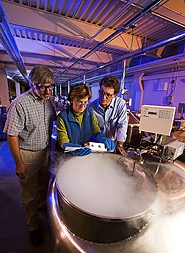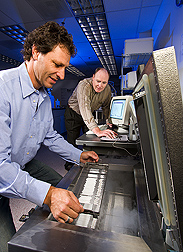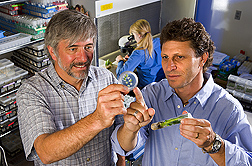United States and Brazil Sow Seeds for Germplasm Exchange
What effect does temperature have on long-term seed storage?
Christina Walters, a plant physiologist at the ARS National Center for Genetic Resources Preservation (NCGRP) in Fort Collins, Colorado, and visiting scientist Luciano Nass, from Brazil, are trying to find out. They’re using germplasm—the genetic material of a plant—from maize, which is an important crop in both nations.
“NCGRP has a lot of data on maize storage, dating back to 1977, which makes it an ideal crop for a comparison study like this,” Walters says.
She and Nass plan to clarify how maize grains respond to both extremely cold cryogenic storage and conventional storage over time. Previous NCGRP research suggests that maize deteriorates faster in the frigid temperatures of cryogenic storage (about –238˚F) than in those of conventional storage (about 0˚F). Walters and Nass want to know why.
They’ll use this information to determine the most economical and efficient method for storing maize germplasm. They may be able to extrapolate the results to other crops as well. This will aid both countries in evaluating the cost efficiency of their respective genebanking systems and could guide future investment decisions.
“This research will show us how to use taxpayers’ money to the greatest advantage,” Walters says. “We want to know which method gives them the most bang for their buck and how we can increase the efficiency and effectiveness of germplasm storage.”
The Virtual Laboratory
This research is one aspect of an ongoing collaborative effort between ARS and its Brazilian counterpart, EMBRAPA (Empresa Brasileira de Pesquisa Agropecuária).
Despite differences in climate, native flora and fauna, and agricultural management practices, the United States and Brazil have a lot in common. Both are large nations with diverse topographies. Both count corn and soybeans among their principal crops. The two nations even face similar agricultural challenges.
In 1998, ARS and EMBRAPA decided to capitalize on the nations’ similarities and the unique perspectives that arise from their differences by organizing a formal agricultural collaboration. The resulting program is Labex, from a Portuguese term meaning “virtual laboratory,” so called because it lacks any physical laboratory buildings of its own.
ARS’s Office of International Research Programs coordinates the Labex program, through which the United States and Brazil share equipment, researchers, and expertise. ARS provides offices, laboratory space, equipment, and supplies to visiting senior scientists from Brazil. EMBRAPA funds the salaries and expenses of the scientists, who are among the most respected and experienced ones in their country.
The program often expands its focus, but previous projects emphasized precision agriculture, animal health, integrated pest management, new uses of commodities, genomics, proteomics, bioinformatics, and global change. Current projects focus on genetic resources, nanotechnology, and food security.
In December 2005, Nass and visiting scientist Arthur Mariante arrived from Brazil to investigate and analyze effective genebank management techniques and encourage international germplasm exchange. This is the first Labex project to deal with genetic resources, says Labex program coordinator Pedro Arraes.
|
|
Updating Animal-GRIN
While Nass has been working in NCGRP’s Plant Germplasm Preservation Research Unit, Mariante spent 6 months working with researchers in the National Animal Germplasm Program. Mariante compared U.S. and Brazilian livestock genetic conservation programs, met with livestock breeders from around the country, and worked with ARS animal geneticist Harvey Blackburn to develop plans for evaluating the genetic diversity of U.S. and Brazilian sheep and cattle populations.
Blackburn and several EMBRAPA leaders have also arranged for a Brazilian computer programmer, Eduardo Vaz de Mello Cajueiro, to work with U.S. programmers in Beltsville, Maryland, to develop a new version of the animal germplasm component of ARS’s Genetic Resources Information Network (GRIN). More Brazilian programmers are expected to participate.
“Currently, Brazil does not have an equivalent database for animals, so this collaboration will help them develop their own national database and document their animal genetic resources,” Blackburn says. “It will help the United States by developing a critical mass of programmers to expedite the development of the animal section of GRIN.”
Once completed, users from both countries will be able to query the database to obtain information on the breeds and individual animals whose germplasm is contained in the nations’ repositories.
“In the future, this information could facilitate international exchange of germplasm or tissues for genomic studies,” Blackburn says.
Going to Seed (Exchange)
Germplasm exchange is an important aspect of this binational collaboration, which is particularly significant because of its uniqueness. International germplasm exchange can be complicated by a variety of factors, so efforts like this are rare.
NCGRP provides long-term, backup storage for about 78 percent of the more than 470,000 plant germplasm accessions within the National Plant Germplasm System and about 300,000 units of semen, embryos, and blood from about 120 livestock breeds collected by the U.S. National Animal Germplasm Program. The Brazilian genebank, located in Brasília and called “Cenargen,” holds about 40 percent of 250,000 accessions of plant germplasm and more than 56,000 semen samples and 200 embryos in support of the Brazilian National Genetic Resource Program, called “Renargen.”
The researchers are encouraging scientists from both countries to identify which germplasm samples they’d like to exchange. Nass and NCGRP curator David Ellis are coordinating the international germplasm exchange from Fort Collins, but it includes all the curators within the U.S. National Plant Germplasm System.
“It’s a practical collaboration,” says Ellis. “The international approach allows us to compare each other’s ways of genebanking and to examine strengths and weaknesses within each system. This will help us develop programs that optimize resources within our own countries, while benefiting from the exchange of information, technology, and germplasm.”
By doing so, both the United States and Brazil can learn much from their shared and individual experiences.—By Laura McGinnis, Agricultural Research Service Information Staff.
This research is part of Food Animal Production (#101) and Plant Genetic Resources, Genomics, and Genetic Improvement (#301), two ARS National Programs described on the World Wide Web at www.nps.ars.usda.gov.
To reach scientists mentioned in this story, contact Laura McGinnis, USDA-ARS Information Staff, 5601 Sunnyside Ave., Beltsville, MD 20705-5129; phone (301) 504-1654, fax (301) 504-1486.
"United States and Brazil Sow Seeds for Germplasm Exchange" was published in the February 2007 issue of Agricultural Research magazine.









